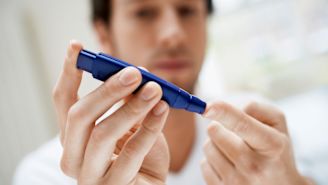Updated on March 21, 2024.
Diabetic retinopathy is one of several forms of diabetic eye disease—conditions and complications that can affect the eyes and vision of people who have diabetes. In its early stages, diabetic retinopathy may cause no symptoms or only mild symptoms. As diabetic retinopathy progresses, it can cause a variety of vision problems—and in the advanced stages, it can result in sudden, severe vision loss and even blindness.
Symptoms of diabetic retinopathy
Diabetic retinopathy damages the part of the eye called the retina. The retina is a layer of light sensitive cells located in the back of the eye. The light sensitive cells that make up the retina are called photoreceptor cells, and act as translators, taking light that passes into the eye and translating it into nerve signals that travel on to the brain by way of the optic nerves, which connect the eyes to the brain so you can see.
When photoreceptor cells become damaged, many different vision problems can occur. Symptoms of diabetic retinopathy may include:
- Fluctuating vision. This refers to frequent changes in how well you see. For example, if your vision is blurry sometimes, but clear other times. Many of the symptoms on this list can fluctuate.
- Floaters. These are dark spots, lines, circles, or cobwebs that “float” across your vision. These occur when tiny clumps of blood, fluid, or other substances have leaked from damaged blood vessels in the eyes and are floating inside the fluid that fills the eyeball. The dark spots are the shadows of these clumps moving across the retina.
- Blind spots. In addition to floaters, a person with diabetic retinopathy may have fixed spots in their vision called blind spots, which are darkened, blurry, or fuzzy areas.
- Blurred or distorted vision. This may affect overall vision or occur in patches.
- Impaired color vision. This can be colorblindness or colors appearing washed out or faded.
- Poor night vision. A person may have difficulty seeing at night or trouble seeing in settings without much light, such as dimly lit rooms. Darkened rooms may appear darker, or your eyes may have difficulty adjusting when the lights are dim.
In some cases, the vision loss caused by diabetic retinopathy is gradual. In other cases, diabetic retinopathy can result in severe and sudden vision loss.
Severe and sudden vision loss
Like every other part of the human body, the retina requires oxygen and nutrients to function well and remain healthy. Blood that contains oxygen and nutrients is pumped to tiny blood vessels in the eyes (while also pumping away blood containing the waste products that are made as the eyes break down oxygen and nutrients).
Diabetes damages and weakens the blood vessels inside the retina. It can also lead to the formation of abnormal blood vessels inside the retina. This is called proliferative diabetic retinopathy. It is the advanced stage of diabetic retinopathy.
Damaged blood vessels and abnormal blood vessels can leak blood and fluid into the eye. In some cases, blood vessels can rupture (hemorrhage), leaking enough blood and fluid into the eye to completely block a person’s vision. It can also cause macular edema—a swelling of the macula, the dense cluster of cells that allow you to see objects directly in front of you (also called central vision).
This sudden loss of vision may resolve as blood clears away from the eye. However, macular edema will require treatment to prevent permanent vision loss. Proliferative diabetic retinopathy can also lead to retinal detachment, as scar tissue pulls the retina away from the back of the eye.
Proliferative diabetic retinopathy can also result in glaucoma (increased pressure inside the eye) that can damage the optic nerve. In diabetic retinopathy, this occurs when new blood vessels block the flow of fluid out of the eye. This leads to an increase in the pressure inside the eye, and pressure on the optic nerve.
Blindness
Diabetic retinopathy has the potential to cause a person to become legally blind or completely blind—in fact, diabetic retinopathy is the leading cause of blindness among people who are of working age in the United States.
Treatment can help slow the progression of diabetic retinopathy and prevent blindness. In the early stages of diabetic retinopathy, treatment focuses on better diabetes control and more frequent eye exams. In later stages, treatment may involve laser surgery, injections of medications to slow the growth of new blood vessels, or other types of surgical procedures. Early treatment can help preserve eyesight better than if treatment is delayed.
If you have questions about managing your diabetes and how it affects the eyes, and treatment for diabetic retinopathy or whether your insurance covers, ask your healthcare provider.







